Flat Tire
Spare Tire and Tool Storage
Spare Tire and Tool Storage
Spare tire and tools are stored in the locations illustrated in the diagram.
4–Door
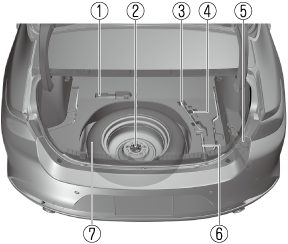
-
Tiedown eyelet (Some Models)
-
Spare tire hold-down bolt
-
Jack lever
-
Flat tire hold-down bolt (Some Models)
-
Jack
-
Lug wrench
-
Spare tire
5–Door
Type A

-
Tiedown eyelet (Some Models)
-
Flat tire hold-down bolt (Some Models)
-
Jack lever
-
Jack
-
Spare tire hold-down bolt
-
Spare tire
-
Lug wrench
Type B

-
Tiedown eyelet (Some Models)
-
Spare tire hold-down bolt
-
Flat tire hold-down bolt
-
Jack lever
-
Jack
-
Spare tire
-
Lug wrench
Jack
Spare Tire
Your Mazda has a temporary spare tire.
The temporary spare tire is lighter and smaller than a conventional tire, and is designed only for emergency use and should be used only for VERY short periods. Temporary spare tires should NEVER be used for long drives or extended periods.
Do not install the temporary spare tire on the front wheels (driving wheels):
Driving with the temporary spare tire on one of the front driving wheels is dangerous. Handling will be affected. You could lose control of the vehicle, especially on ice or snow bound roads, and have an accident. Move a regular tire to the front wheel and install the temporary spare tire to the rear.
-
When using the temporary spare tire, driving stability may decrease compared to when using only the conventional tire. Drive carefully.
-
To avoid damage to the temporary spare tire or to the vehicle, observe the following precautions:
-
Do not exceed 80 km/h (50 mph).
-
Avoid driving over obstacles. Also, do not drive through an automatic car wash. This tire's diameter is smaller than a conventional tire, so the ground clearance is reduced.
-
Do not use a tire chain on this tire because it will not fit properly.
-
Do not use your temporary spare tire on any other vehicle, it has been designed only for your Mazda.
-
Use only one temporary spare tire on your vehicle at the same time.
-
To remove the spare tire
4–Door
-
Remove the trunk mat.
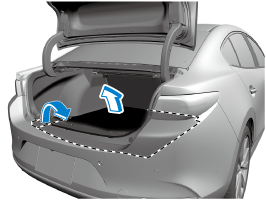
-
Turn the spare tire hold-down bolt counterclockwise and remove the spare tire.
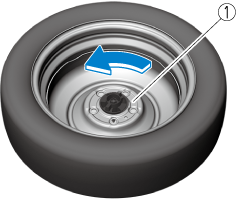
-
Spare tire hold-down bolt
If the spare tire hold-down bolt cannot be loosened, hold the edge of the tire and turn it counterclockwise until the spare tire hold-down bolt rotates.
-
5–Door
-
Remove the luggage mat.
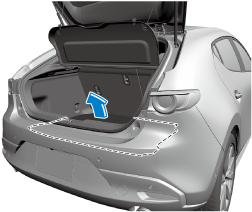
-
(Vehicles with sub-woofer)
Uncouple the sub-woofer connector.
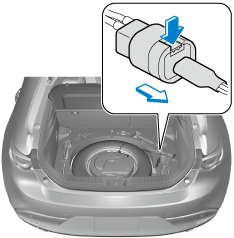
Extra strength may be required to uncouple the connector. Be sure to squeeze the tab firmly.
-
(Vehicles with sub-woofer)
Turn the spare tire hold-down bolt counterclockwise and remove the sub-woofer and the spare tire.
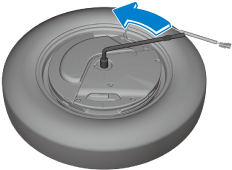
(Vehicles without sub-woofer)
Turn the spare tire hold-down bolt counterclockwise and remove the spare tire.

-
Spare tire hold-down bolt
If the spare tire hold-down bolt cannot be loosened, hold the edge of the tire and turn it counterclockwise until the spare tire hold-down bolt rotates.
-
To secure the spare tire
Store the spare tire in the reverse order of removal. After storing, verify that the spare tire is stored securely.
Changing a Flat Tire
Changing a Flat Tire
If the following occurs while driving, it could indicate a flat tire.
-
Steering becomes difficult.
-
The vehicle begins to vibrate excessively.
-
The vehicle pulls in one direction.
If you have a flat tire, drive slowly to a level spot that is well off the road and out of the way of traffic to change the tire.
Stopping in traffic or on the shoulder of a busy road is dangerous.
Be sure to follow the directions for changing a tire:
Changing a tire is dangerous if not done properly. The vehicle can slip off the jack and seriously injure someone.
No person should place any portion of their body under a vehicle that is supported by a jack.
Never allow anyone inside a vehicle supported by a jack:
Allowing someone to remain in a vehicle supported by a jack is dangerous. The occupant could cause the vehicle to fall resulting in serious injury.
-
Park on a hard, level surface off the right-of-way and firmly set the parking brake.
-
Put a vehicle with an automatic transmission in Park (P), a manual transmission in Reverse (R) or 1, and turn off the engine.
-
Turn on the hazard warning flasher.
-
Have passengers get out of the vehicle and away from the vehicle and traffic.
-
Remove any luggage, the jack, tools, and spare tire (Search).
-
Block the wheel diagonally opposite the flat tire. When blocking a wheel, place a tire block both in front and behind the tire.

When blocking a tire, use rocks or wood blocks of sufficient size if possible to hold the tire in place.
Removing a Flat Tire
When jacking-up a vehicle, always shift the shift lever to 1st or R position (manual transmission vehicle) or shift the selector lever to P position (automatic transmission vehicle), apply the parking brake, and place wheel blocks in the position diagonally opposed to the jack:
Changing a flat tire without using wheel blocks is dangerous because the vehicle may move and fall off the jack even with the shift lever in 1st or R position, or the selector lever is in P position, which could result in an accident.
-
If your vehicle is equipped with a wheel cover, pry off the wheel cover with the beveled end of the jack lever.
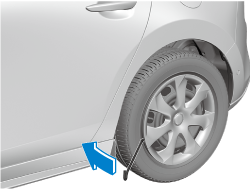
Force the end of the jack lever firmly between wheel and cover, or removal will be difficult.
Align the notch on the wheel cover with the valve stem when installing it.

-
Notch
-
Tire valve
Damage could occur during installation if the wheel cover is not properly aligned.
-
-
Loosen the lug nuts by turning them counterclockwise one turn each, but do not remove any lug nuts until the tire has been raised off the ground.

If your Mazda is equipped with the optional antitheft wheel lug nuts, a special key must be used to unlock the locking lug nut for each wheel. For details, refer to the Locking Lug Nuts (Search).
-
Place the jack on the ground.
-
Turn the jack screw in the direction shown in the figure and adjust the jack head so that it is close to the jack-up position.
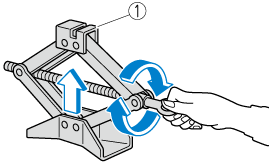
-
Jack head
-
-
Place the jack under the jack-up position closest to the tire being changed with the jack head squarely under the jack-up point.

-
Jacking position
-
-
Continue raising the jack head gradually by rotating the screw with your hand until the jack head is inserted into the jack-up position.
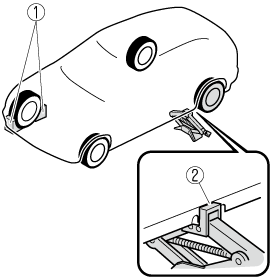
-
Tire blocks
-
Jacking position
Use only the front and rear jacking positions recommended in this manual:
Attempting to jack the vehicle in positions other than those recommended in this manual is dangerous. The vehicle could slip off the jack and seriously injure or even kill someone. Use only the front and rear jacking positions recommended in this manual.
Do not jack up the vehicle in a position other than the designated jack-up position or place any objects on or under the jack:
Jacking up the vehicle in a position other than the designated jack-up position or placing objects on or under the jack is dangerous as it could deform the vehicle body or the vehicle could fall off the jack resulting in an accident.
Use only the jack provided with your Mazda:
Using a jack that is not designed for your Mazda is dangerous. The vehicle could slip off the jack and seriously injure someone.
Never place objects under the jack:
Jacking the vehicle with an object under the jack is dangerous. The jack could slip and someone could be seriously injured by the jack or the falling vehicle.
When raising the jack head into the jacking position and aligning the groove in the jack head with the rail under the vehicle body, the top of the jack head contacts the vehicle's underbody without the rail contacting the bottom of the groove.
-
-
Insert the jack lever and attach the lug wrench to tire jack.
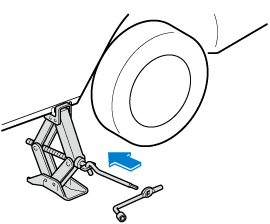
-
Turn the jack handle clockwise and raise the vehicle high enough so that the spare tire can be installed. Before removing the lug nuts, make sure your Mazda is firmly in position and that it cannot slip or move.
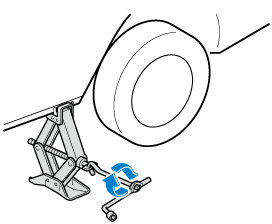
Do not jack up the vehicle higher than is necessary:
Jacking up the vehicle higher than is necessary is dangerous as it could destabilize the vehicle resulting in an accident.
Do not start the engine or shake the vehicle while it is jacked up:
Starting the engine or shaking the vehicle while it is jacked up is dangerous as it could cause the vehicle to fall off the jack resulting in an accident.
Never go under the vehicle while it is jacked up:
Going under the vehicle while it is jacked up is dangerous as it could result in death or serious injury if the vehicle were to fall off the jack.
-
Remove the lug nuts by turning them counterclockwise; then remove the wheel and center cap.
Locking Lug Nuts
If your Mazda is equipped with the optional antitheft wheel lug nuts, a special key must be used to unlock the locking lug nut for each wheel. The key is stored in the glove compartment, center console storage, storage box, or trunk. Register the key and lug nuts with the lock manufacturer by filling out the registration card and mailing it in using the accompanying envelope. If the key is lost, consult an Authorized Mazda Dealer or use the lock manufacturer’s order form to order a new key.
Antitheft wheel lug nuts cannot be installed on a steel wheel spare tire. When installing a temporary spare tire, use one of the original lug nuts in place of the locking lug nut. The original lug nuts are stored inside your Mazda.
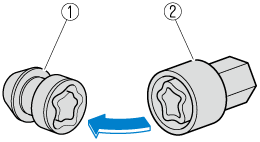
-
Antitheft lug nut
-
Special key
To remove an antitheft lug nut
-
Obtain the special key for the antitheft lug nut.
-
Place the special key on top of the antitheft lug nut, and be sure to hold the key square to it. If you hold the key at an angle, you may damage both key and nut. Do not use a power impact wrench.
-
Place the lug wrench on top of the key and apply pressure. Turn the wrench counterclockwise.
To install the antitheft lug nut
-
Place the special key on top of the nut, and be sure to hold the key square to it. If you hold the key at an angle, you may damage both key and nut. Do not use a power impact wrench.
-
Place the lug wrench on top of the special key, apply pressure, and turn it clockwise.
|
Nut tightening torque |
|
|---|---|
|
N·m (kgf·m, ft·lbf) |
108―147 (12―14, 80―108) |
Mounting the Spare Tire
-
Remove dirt and grime from the mounting surfaces of the wheel and hub, including the hub bolts, with a cloth.
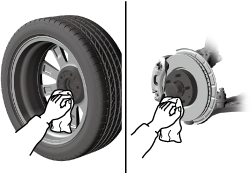
Make sure the mounting surfaces of the wheel, hub and lug nuts are clean before changing or replacing tires:
When changing or replacing a tire, not removing dirt and grime from the mounting surfaces of the wheel, hub and hub bolts is dangerous. The lug nuts could loosen while driving and cause the tire to come off, resulting in an accident.
-
Mount the spare tire.
-
Install the lug nuts with the beveled edge inward; tighten them by hand.
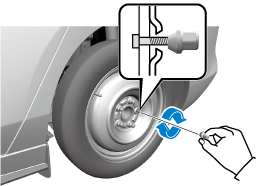
Do not apply oil or grease to lug nuts and bolts and do not tighten the lug nuts beyond the recommended tightening torque:
Applying oil or grease to lug nuts and bolts is dangerous. The lug nuts could loosen while driving and cause the tire to come off, resulting in an accident. In addition, lug nuts and bolts could be damaged if tightened more than necessary.
-
Turn the jack handle counterclockwise using the lug wrench and lower the vehicle.
-
Use the lug wrench to tighten the nuts in the order shown.
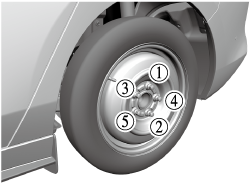
If you are unsure of how tight the nuts should be, have them inspected at an Authorized Mazda Dealer.
Nut tightening torque
N·m (kgf·m, ft·lbf)
108―147 (12―14, 80―108)
Always securely and correctly tighten the lug nuts:
Improperly or loosely tightened lug nuts are dangerous. The wheel could wobble or come off. This could result in loss of vehicle control and cause a serious accident.
Be sure to reinstall the same nuts you removed or replace them with metric nuts of the same configuration:
Because the wheel studs and lug nuts on your Mazda have metric threads, using a non-metric nut is dangerous. On a metric stud, it would not secure the wheel and would damage the stud, which could cause the wheel to slip off and cause an accident.
-
(Aluminum wheel equipped vehicle)
Remove the center cap by tapping it from the backside of the wheel using the lug wrench.
-
Store the damaged tire in the trunk (4-door) or luggage compartment (5-door).

-
Secure the damaged tire to the vehicle using the following method.
(Vehicles with flat tire hold-down bolt (excluding vehicles with sub-woofer for 5-door))
-
Spread apart the tabs on the spare tire hold-down bolt that was removed when removing the spare tire and remove the bolt for securing the spare tire.

-
Tabs
-
Bolt for securing spare tire
-
Spare tire hold-down bolt
-
-
Remove the bolt for securing the flat tire from its stored position and install it in place of the removed spare tire hold-down bolt.
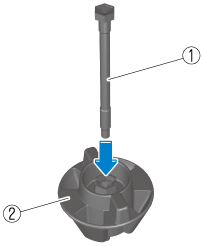
-
Bolt for securing the flat tire
-
Spare tire hold-down bolt
The longer bolt is used as the bolt for securing the flat tire, and the shorter one is used as the bolt for securing the spare tire. When installing a bolt, check the bolt's length.
-
-
Secure the damaged tire to the vehicle using the flat tire hold-down bolt.
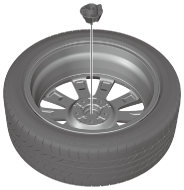
(Vehicles with flat tire hold-down bolt and with sub-woofer for 5-door))
-
Remove the bolt for securing the flat tire from its stored position.
-
Secure the damaged tire to the vehicle using the flat tire hold-down bolt.
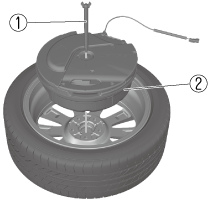
-
Flat tire hold-down bolt
-
Sub-woofer
-
(Vehicles without flat tire hold-down bolt)
-
Secure the damaged tire to the vehicle using the spare tire hold-down bolt removed when removing the spare tire.

-
-
Place the trunk mat (4-door) or luggage mat (5-door) on the damaged tire.
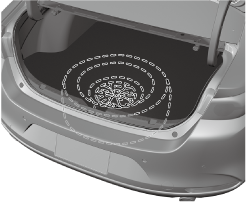
-
Remove the tire blocks and store the tools and jack.
-
Check the inflation pressure. Refer to Tires (Search).
-
Have the flat tire repaired or replaced as soon as possible.
-
After repairing or replacing the flat tire, install the wheel cover (vehicles with steel wheels) or center cap (vehicles with aluminum wheels) using the following procedure.
(Wheel cover)
-
Align the notch on the wheel cover with the tire valve of the wheel and install the wheel cover to the wheel.
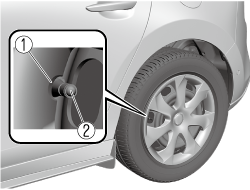
-
Notch
-
Tire valve
Always align the notch on the wheel cover with the tire valve of the wheel. Otherwise, it could cause damage to the wheel cover and the tire valve.
-
(Center cap)
-
Align the center cap with the center hole of the wheel and install the center cap to the wheel.
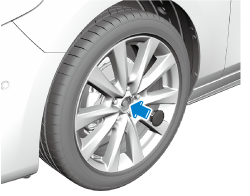
-
Do not drive with any tires that have incorrect air pressure:
Driving on tires with incorrect air pressure is dangerous. Tires with incorrect pressure could affect handling and result in an accident. When you check the regular tires' air pressure, check the spare tire, too.




















































